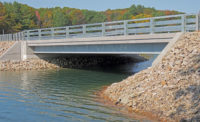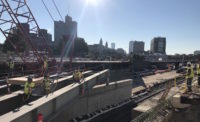Best of the Best
Best Highway/Bridge - Chelsea Viaduct Rehabilitation

Contractors used accelerated bridge construction to demolish and rehabilitate the bridge.
Photo courtesy of Skanska
Chelsea Viaduct Rehabilitation
Chelsea, Mass.
Best Highway/Bridge
Submitted By: Skanska USA
Owner: Massachusetts Dept. of Transportation
Lead Design Firm/Structural, Civil, MEP, Geotechnical, Lighting & Electrical Engineer: HNTB
General Contractor: Skanska/McCourt Joint Venture
Providing a 75-year design life for the structurally deficient critical link between the city of Chelsea, Mass., its northern suburbs and Boston, the rehabilitation of the Chelsea Viaduct involved night work with heavy equipment and posed many risks. The fast-track, $190-million project reconstructed on/off ramps, rehabilitated a segment of the Tobin Bridge’s upper deck and upgraded parking lots and surface streets below the viaduct—along with repairing and retrofitting the substructure. Built in the 1950s, the viaduct includes 76 spans that cross several city streets and the Massachusetts Bay Transportation Authority’s commuter rail line. It carries 63,000 vehicles per day on U.S. Route 1—a primary route for North Shore commuters—through Chelsea.
Crews used accelerated bridge construction techniques to demolish and rehabilitate the bridge, replacing existing spans with 313 prefabricated bridge units, 198 grid deck panels and 124 paired frames for isolated spans built using standard cast-in-place techniques. Finished on budget and on schedule, the project was designed for nighttime construction atop the highway, but the team devised an innovative staging design allowing for less risky work, mostly on the ground during daytime. This cut two years of night work and saved 10% in costs for the Massachusetts Dept. of Transportation. Conflicts in design drawings impacted steel fabrication in early construction, but the team caught up through creative staging and project acceleration.
Pandemic work disruption caused additional delay, but resequencing allowed for completion only five days beyond the original schedule. When the team analyzed the structure using VDC technology, it discovered a discrepancy in sister beam metrics for 15 bridges. With early detection, the design engineer was able to correct the problem and steel was delivered on time with no need for refabrication.



